Physical Address
304 North Cardinal St.
Dorchester Center, MA 02124
Influenza A and B viruses are antigenically, ecologically, and epidemiologically distinct members of the family Orthomyxoviridae that have segmented, negative-sense RNA genomes and are surrounded by a lipid envelope. Globally, both virus groups are associated with an enormous burden of human disease. In the United States, influenza virus infections affect an estimated 5% to 20% of the population each year. From 1976 to 2007, an estimated 21,600 average annual excess deaths (range, 3300 to 48,600) resulted from circulatory or respiratory causes associated with influenza. In the United States, an estimated average of 226,000 influenza-related hospitalizations (range, 55,000 to 431,000) occurred annually from 1979 through 2001.
Influenza A viruses are classified into subtypes based on the antigenicity of their hemagglutinin (HA) and neuraminidase (NA) surface glycoproteins. There are 16 recognized HA subtypes and 9 NA subtypes of influenza A virus. Influenza A occurs in both pandemic and interpandemic forms. The epidemiology of influenza A is associated with two types of antigenic variation of the viral glycoproteins, designated as antigenic drift and antigenic shift. Interpandemic influenza A occurs every year, caused by antigenic drift resulting from point mutations in the surface glycoprotein genes and the emergence of new strains related to those circulating in previous epidemics. This enables the virus to evade the immune system, leading to repeated outbreaks during interpandemic years. Antigenic shift occurs from reassortment of glycoprotein genes in a wide range of avian and mammalian hosts, and this process may produce pandemic influenza. Pandemics, defined as worldwide outbreaks of severe disease, occur infrequently and result from the emergence of new potentially pandemic influenza A viruses that possess a novel HA alone or in combination with a novel NA. In the spring of 2009, a novel influenza A (H1N1) virus emerged in North America and spread worldwide to cause the first influenza pandemic since 1968 ( Figure 6-1 ).
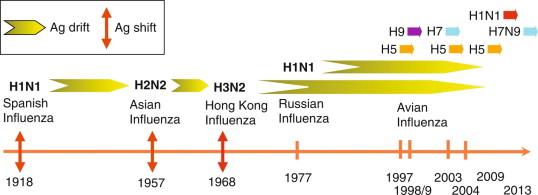
Influenza B viruses do not undergo antigenic shift or cause pandemics, and antigenic drift occurs more slowly than with influenza A viruses. A single type of HA and one of NA are recognized for influenza B viruses. Only two distinct lineages, comprising the Victoria-like and Yamagata-like strains, circulate currently among human populations and the only known wildlife hosts of influenza B viruses are seals. Influenza B viruses seldom predominate during seasonal influenza epidemics, but when this occurs, mortality statistics are generally intermediate to those attributable to the various influenza A virus subtypes.
Influenza A virus infections are spread primarily from person to person through coughing and sneezing with a typical incubation period of 1 to 4 days. Adults can be infectious from the day before onset of symptoms through approximately 5 days after illness onset. Children can be infectious for > 10 days, and young children can shed virus for several days before the onset of illness. Severely immunocompromised persons can shed virus for weeks or months.
Respiratory illness caused by influenza A is difficult to distinguish from illnesses caused by other respiratory pathogens based on symptoms. Influenza has an abrupt onset with both constitutional and respiratory signs and symptoms including fever, myalgia, headache, malaise, nonproductive cough, sore throat, and rhinitis. Among children, otitis media, nausea, and vomiting are also commonly reported. Influenza usually resolves in 3 to 7 days, though cough and malaise can last for over 2 weeks. In some patients with underlying pulmonary or cardiac disease, influenza can be complicated by primary influenza viral pneumonia or secondary bacterial pneumonia. Young children with influenza may have initial symptoms that resemble bacterial sepsis. Febrile seizures can occur in about a quarter of hospitalized children. Influenza A has also been associated with encephalopathy, transverse myelitis, Reye syndrome, myositis, myocarditis, and pericarditis. The risks for complications, hospitalizations, and deaths from influenza are higher among persons aged > 65 years, young children, pregnant women, and persons of any age with underlying health conditions such as morbid obesity, diabetes, and underlying respiratory illness.
Influenza B is clinically indistinguishable from seasonal influenza A. Most patients with influenza B infection develop high fever (often above 39° C), a dry hacking cough, and rhinorrhea. A nonexudative pharyngitis and headache are frequently described. Other commonly reported manifestations, particularly in children, include vomiting, diarrhea, abdominal pain, and myalgias involving particularly the soleus and gastrocnemius muscles. Severe manifestations include encephalopathy, myocardial injury, and bacterial pneumonias, most frequently caused by Staphylococcus aureus or Streptococcus species.
Influenza viruses belong to the virus family Orthomyxoviridae and have a segmented, negative-sense RNA core surrounded by a lipid envelope.
Influenza A and B viruses are associated with an enormous disease burden each year.
Influenza A viruses are classified into subtypes based on the antigenicity of their hemagglutinin (HA) and neuraminidase (NA) surface glycoproteins.
There are 16 recognized HA subtypes and 9 NA subtypes of influenza A virus, but only one recognized HA and NA for influenza B viruses.
Influenza viruses are distributed throughout the world.
Influenza A occurs in both pandemic and interpandemic forms.
Seasonal influenza is caused by influenza A and influenza B viruses.
In the United States, influenza virus infections affect an estimated 5% to 20% of the population each year.
Influenza is rarely fatal in the immunocompetent host, and recovery is usually complete.
Bacterial coinfections with Staphylococcus aureus, Streptococcus pneumoniae, Streptococcus pyogenes, or Haemophilus influenzae occur in approximately 40% to 90% of fatal influenza virus infections.
The risks for complications, hospitalizations, and deaths from influenza are greatest for persons aged > 65 years, children < 5 years, and persons of any age with certain underlying health conditions including cardiovascular disease, diabetes mellitus, seizure disorders, and immunosuppressive conditions.
Influenza viruses are spread person to person primarily by coughing and sneezing of infected persons and have a typical incubation period of 1 to 4 days.
Seasonal influenza A virus infection is clinically indistinguishable from seasonal influenza B virus infection.
Uncomplicated seasonal influenza is characterized by an abrupt onset of fever, myalgia, headache, malaise, nonproductive cough, sore throat, and rhinitis.
Otitis media, nausea, vomiting, and myalgias involving particularly the soleus and gastrocnemius muscles are more commonly reported in children.
Influenza may also be associated with encephalopathy, transverse myelitis, Reye syndrome, myositis, myocarditis, and myocardial injury.
Chest radiographs in uncomplicated disease are often normal; more severe infections show diffuse infiltrates, mottled densities, and unilateral or bilateral consolidations.
Pleural effusions are uncommon and suggest bacterial coinfection.
Supportive therapy consists of bed rest, oral hydration, and antipyretics.
Most uncomplicated infections resolve within 3 to 7 days, although cough and malaise may last more than 2 weeks.
Antivirals such as oseltamivir, zanamivir, and amantadine may be helpful early in the course of infection.
Specific antibiotic therapy is used in cases with secondary bacterial infection.
Vaccination is an important preventive strategy.
In cases of uncomplicated influenza, chest radiographs are usually normal; however, more severe infections reveal mottled densities in multiple lobes, diffuse interstitial infiltrates, or unilateral or bilateral pulmonary consolidations ( Figure 6-2 ). Consolidation is usually ill defined and may progress to confluent lung disease. Cavitations or pleural effusions suggest bacterial coinfection.
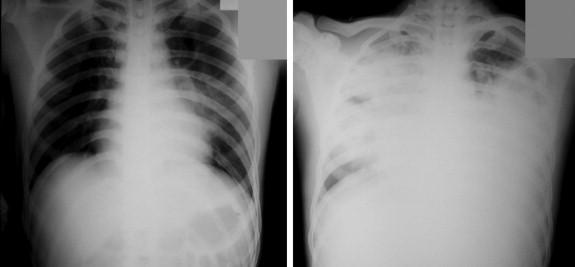
In cases of fatal influenza pneumonia, the lungs are typically heavy and demonstrate prominent congestion, edema, and occasional hemorrhages. The mucosal surfaces of the trachea and large bronchi are usually hyperemic and swollen and the lumens may contain exudates. In bacterial coinfections, purulent necrotic debris is often prominent in the distal trachea and bifurcation. The gross pathology of the lower lobes is typically more severe than in the upper lobes and may include abscesses, hemorrhages, and empyema. Enlarged regional lymph nodes, purulent mediastinitis, and pericarditis can also be seen.
In patients with uncomplicated seasonal influenza, a diffuse, superficial, necrotizing tracheobronchitis is evident, particularly in the more distal aspects of the large bronchi. Less severely involved areas of respiratory epithelium may show vacuolization, pyknotic nuclei, cellular edema, and loss of cilia. The histopathologic features of fatal seasonal influenza A virus infections are indistinguishable from those associated with fatal influenza B virus infection. In these patients, the epithelial surfaces of the trachea and bronchi are generally ulcerated and often associated with necrosis, hemorrhage, and prominent inflammatory cell infiltrates comprising predominantly lymphocytes, plasma cells, and macrophages. These infiltrates typically involve the lamina propria but may also extend into the submucosa to involve seromucinous glands and ciliated ducts ( Figure 6-3 ). Marked congestion of mural capillaries and edema of adjacent connective tissues are commonly identified. Despite extensive damage to the surface epithelium, the basal layer and basement membrane are often preserved ( Figure 6-4 ). Careful inspection of the submucosal glands may reveal necrosis of individual acinar cells ( Figure 6-5A ). Unlike many other respiratory viruses, intracellular viral inclusions cannot be identified by light microscopy in infected cells ( Figures 6-5B and 6-6A, B ). Lymph nodes adjacent to the trachea and bronchi are often hyperplastic and frequently demonstrate erythrophagocytosis ( Figure 6-7 ). In the lungs, the most frequently identified histologic finding in patients with fatal seasonal influenza is diffuse congestion. Other commonly observed features include varying degrees of bronchiolitis, intra-alveolar hemorrhage and edema, and interstitial pneumonia ( Figure 6-8 ). Alveolitis and diffuse alveolar damage are identified only occasionally ( Figure 6-9A, B ). Each of these features can be identified in fatal pandemic influenza A (H1N1) and avian influenza A (H5N1); however, the predominant histopathologic findings in the lung are various phases of diffuse alveolar damage ( Figures 6-10 and 6-11 ). Concomitant bacterial pneumonias, particularly those caused by Streptococcus pyogenes, Streptococcus pneumoniae, S. aureus, and Haemophilus influenzae, occur in approximately 40% to 90% of fatal seasonal and pandemic influenza virus infections and may obscure the pathologic changes associated with the primary viral infection ( Figure 6-12 ). This is particularly characteristic of staphylococcal pneumonia that produces diffusely necrotic and hemorrhagic lesions, which often obliterate the normal architecture of the involved pulmonary parenchyma.
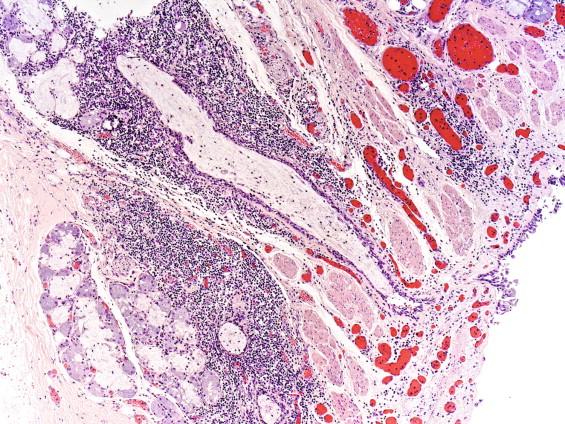
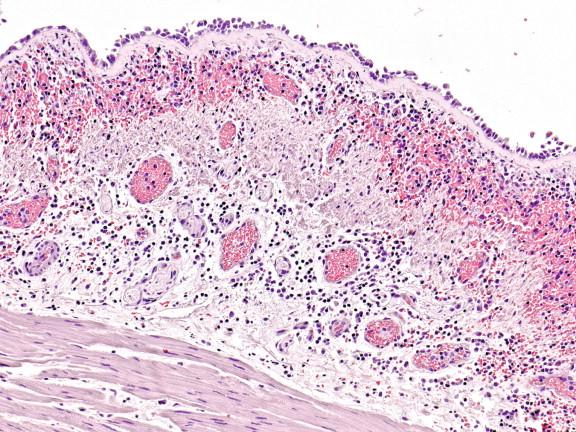
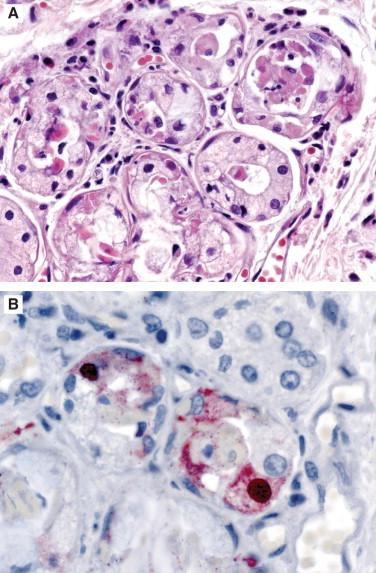
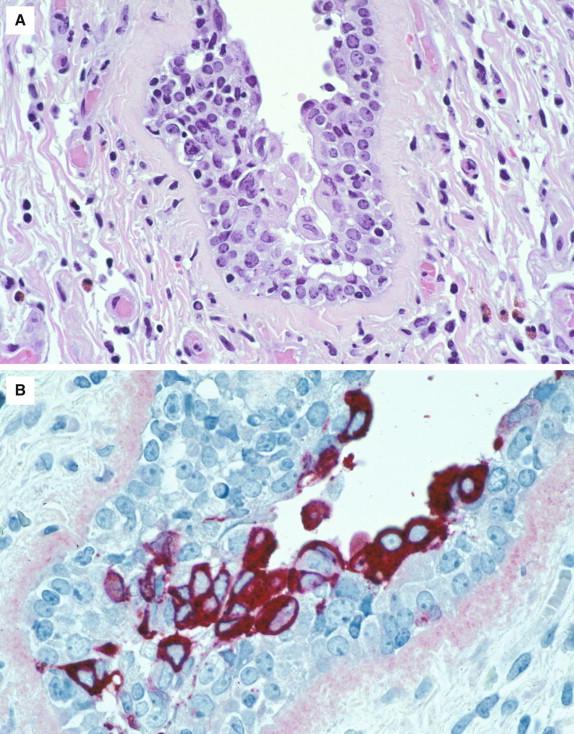
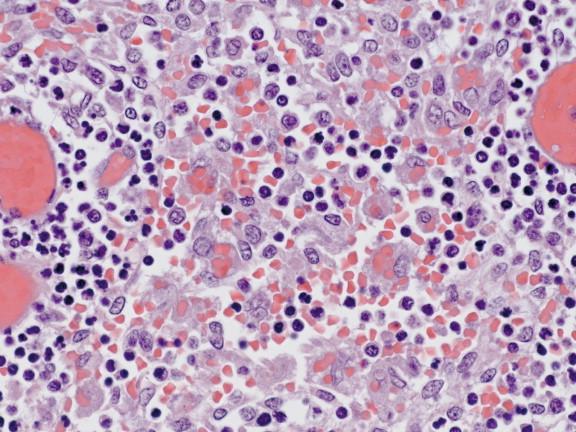
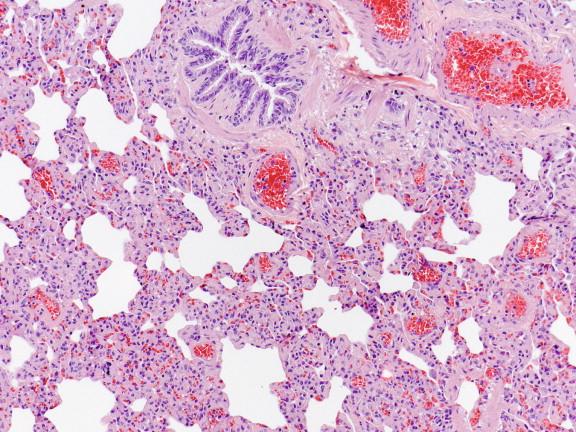
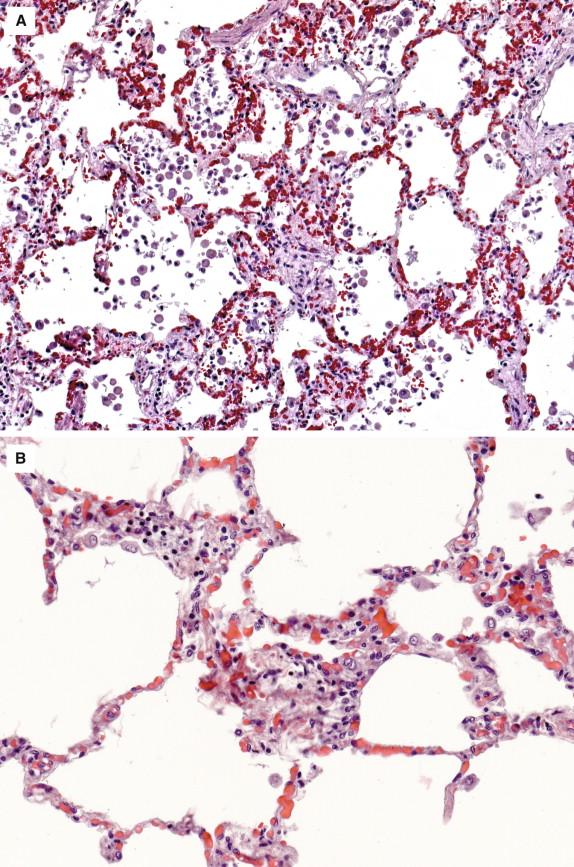
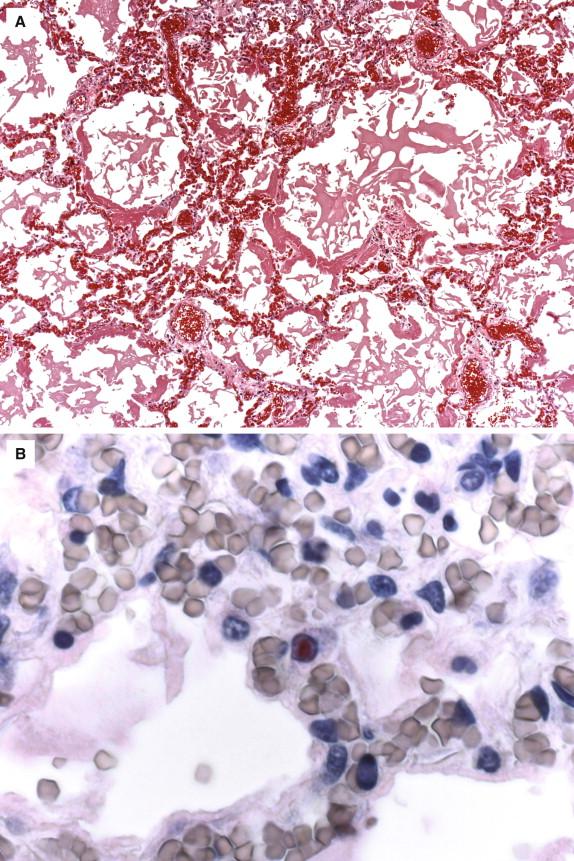
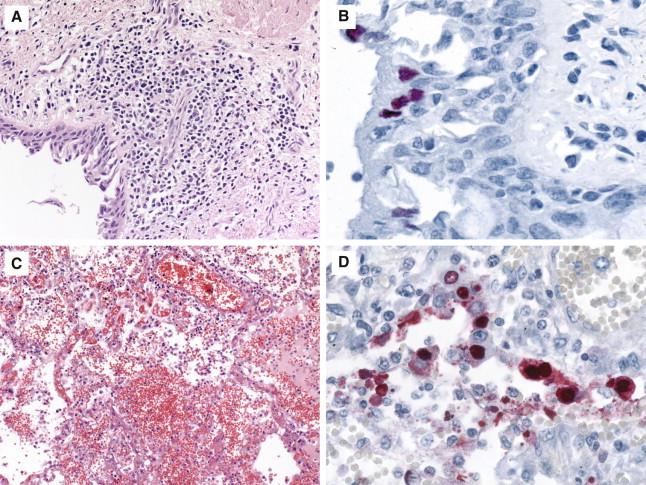
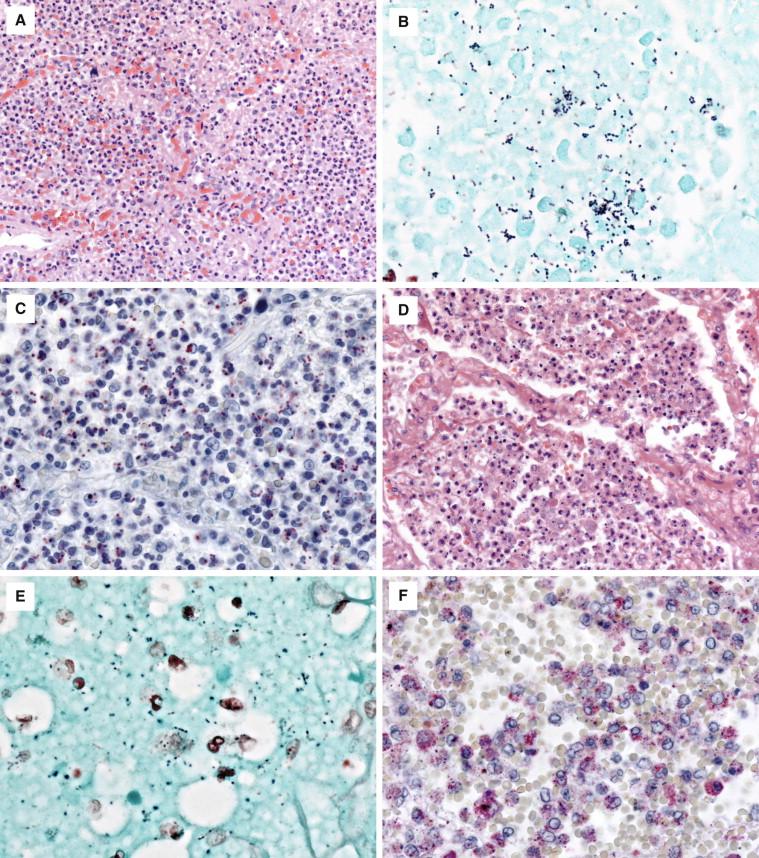
In seasonal influenza A and B virus infections, immunohistochemical (IHC) assays demonstrate sparse viral antigens predominantly in the nuclei and cytoplasm of respiratory epithelial cells of the upper airways and larger bronchioles, and occasionally in submucosal glands of the trachea and bronchi ( Figure 6-13 ). In contrast, antigens of avian influenza A (H5N1) and pandemic influenza A (H1N1) viruses are characteristically identified in alveolar pneumocytes ( Figure 6-10B and 6-11D, F ). Antigens of pandemic influenza A (H1N1) virus can also be seen in respiratory epithelial cells of the trachea, bronchi, and bronchioles, in a pattern that reflects the ability of this virus to target both upper and lower respiratory tracts ( Figure 6-11B ). In situ hybridization and electron microscopy demonstrate replicating and intact viral particles in infected respiratory tissues identified by IHC techniques ( Figure 6-14 ). Histopathologic features of fatal influenza virus infections are seen occasionally in other organs and tissues and include myocarditis and myocardial injury, cerebral edema, and rhabdomyolysis ( Figure 6-15 ).
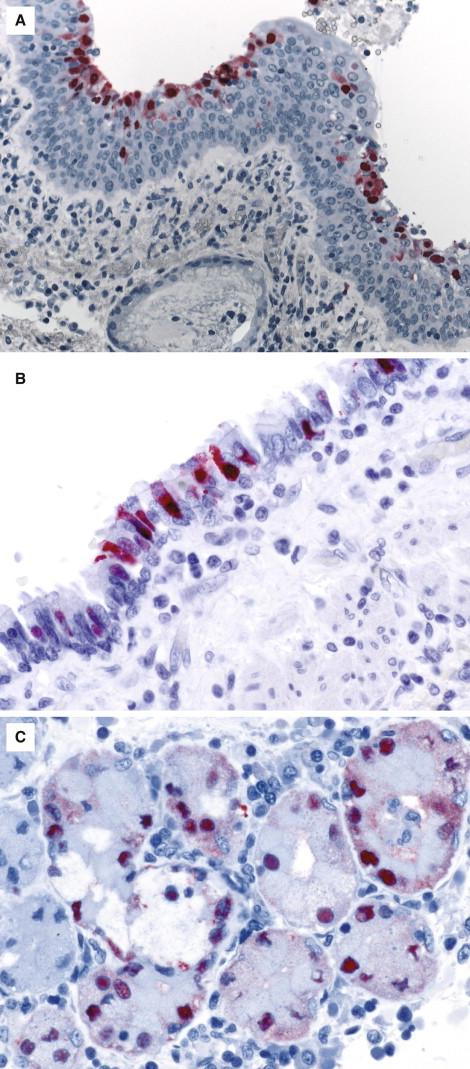
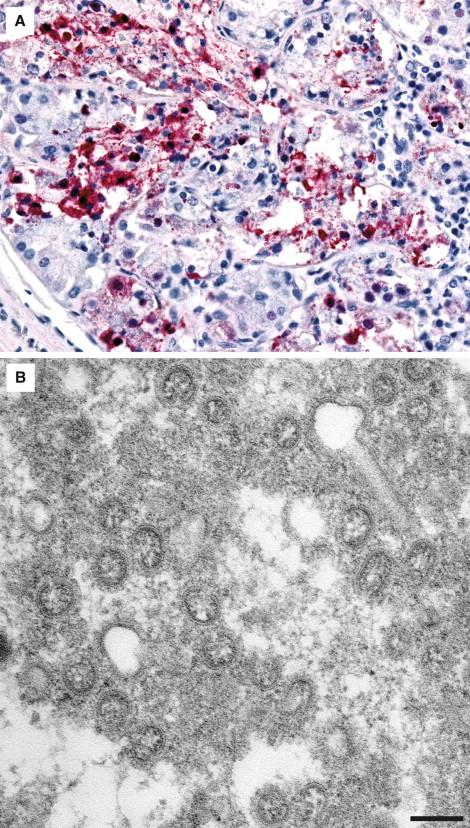
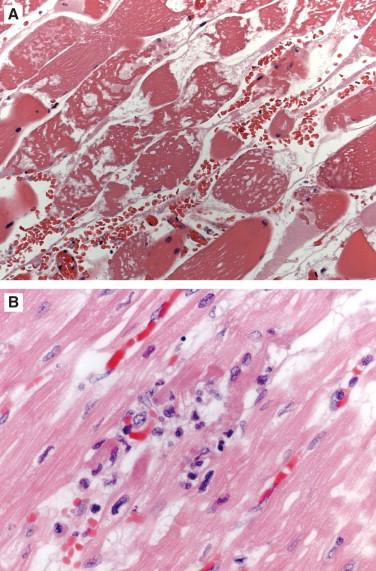
Studies suggest that avian influenza A (H5N1) virus preferentially infects cells in alveolar spaces of humans, resulting in extensive damage to the lungs but minimal pathology to the upper respiratory tract. Avian influenza A (H5N1) virus preferentially binds to the α-2,3 galactose receptors, which are found only in and around the alveoli. This is in contrast to the seasonal influenza A and B viruses, which preferentially bind to α-2,6 receptors that predominate on the epithelial cells that line of the respiratory tract from the nose to the lungs. This may help explain why the avian influenza A (H5N1) virus is so lethal to humans and why person-to-person spread is uncommon.
In fatal influenza infections, the lungs are generally heavy, congested, and edematous.
The mucosal surfaces of the trachea and large bronchi are usually hyperemic and swollen. These changes are typically more severe in lower trachea and large bronchi.
Bacterial coinfections may be associated with purulent luminal debris in large airways and abscesses, hemorrhage, or empyema in the lungs.
The histopathologic changes of seasonal influenza A and B virus infections are indistinguishable and are most consistently identified in the large airways.
Uncomplicated seasonal influenza infection is characterized by a diffuse, superficial, necrotizing tracheobronchitis, particularly in the more distal aspects of the large bronchi.
In avian influenza A (H5N1) the predominant pathology is identified in lung parenchyma.
In pandemic influenza A (H1N1) the pathology includes inflammation of the large airways and diffuse alveolar damage.
Viral inclusions cannot be identified by light microscopy.
Secondary bacterial infections may make it difficult to recognize the pathologic changes associated with the primary viral infection.
Histopathologic features in other organs may include myocarditis and myocardial injury, cerebral edema, rhabdomyolysis, and hemophagocytosis in regional lymph nodes.
Influenzavirus particles are pleomorphic (filamentous and spherical).
A 10- to 12-nm layer of HA (rod-shaped) and NA (mushroom-shaped) spikes project radially on the surface of the influenza A and B viruses.
In seasonal influenza A and B infections, viral antigens are usually sparse and are identified primarily in the respiratory epithelial cells lining the distal trachea and bronchi.
In avian influenza A (H5N1) virus infections, antigens are predominantly found in lung parenchyma.
In pandemic influenza A (H1N1) virus infections, viral antigens are seen in both upper and lower airways.
Viral antigens are most frequently identified by IHC in tissues of those patients who die within 4 days of the illness onset.
The histopathologic appearance may resemble the pathology observed with other causes of tracheobronchitis and pneumonia, including parainfluenza viruses, respiratory syncytial virus, coronaviruses, human metapneumoviruses, and Mycoplasma pneumoniae .
Ancillary diagnostics include viral culture, direct fluorescent antibody techniques, rapid antigen assays, and reverse transcription-polymerase chain reaction (RT-PCR).
Currently available diagnostic assays for influenza virus infections include viral culture, direct fluorescent antibody and rapid antigen detection, and real-time RT-PCR assays. The sensitivity of each method is dependent largely upon the timing of specimen collection and the quality of the sample. Nasopharyngeal swabs or aspirates are preferred, and the diagnostic yield from this type of sample is greatest during the first few days of illness. Immunohistochemical staining of formalin-fixed, paraffin-embedded tissues provides an extremely important adjunct to the diagnosis of fatal influenza, particularly when premortem specimens are not available or are nondiagnostic. In general, influenza virus antigens are more readily detected by IHC in respiratory tissues of patients who have died within 4 days of illness onset. Viral antigens are more difficult to detect by IHC in patients with prolonged illnesses or when there is extensive necrosis of airway epithelium or pulmonary parenchyma caused by bacterial coinfections, particularly S. aureus . In these circumstances, RT-PCR evaluation of fresh or formalin-fixed tissue is a more sensitive diagnostic method.
The histologic findings identified in patients with severe seasonal influenza A and B virus infections are indistinguishable and may resemble the pathology observed with other causes of tracheobronchitis and pneumonia, including parainfluenza viruses, respiratory syncytial virus, coronaviruses, human metapneumoviruses, and Mycoplasma pneumoniae . Prominent inflammatory cell infiltrates and conspicuous epithelial damage in the large airways are consistent features of influenza virus infections.
Influenza is rarely fatal in the immunocompetent host and recovery is usually complete. Supportive management with bed rest, hydration, and antipyretics is the basis of treatment. In addition to children < 5 years of age and the elderly, patients with certain preexisting conditions including asthma, cardiovascular disease, seizure disorders, malignancies, diabetes mellitus, or pregnancy are at greater risk for severe illness, and life-threatening infections occur most frequently among these patient groups.
Antiviral agents may be helpful early in the course of illness. The drugs oseltamivir and zanamivir act by inhibiting function of the influenza virus neuraminidase. The adamantane drugs, amantadine and rimantadine, function as inhibitors of the M2 ion channel protein of influenza viruses; however, this class of drugs is not active against influenza B viruses at clinically achievable levels, and influenza A (H3N2) and pandemic influenza A (H1N1) viruses are now considered resistant to the adamantanes.
Vaccination is an important strategy in the prevention of influenza A virus infections. An injectable inactivated virus vaccine and an inhaled live attenuated virus vaccine are available in the United States. Both are trivalent preparations that include the influenza A and influenza B strains considered most likely to circulate during the upcoming influenza season.
Respiratory syncytial virus (RSV) is the most important cause of acute lower respiratory infections in young children. Global estimates suggest that RSV is responsible for approximately 34 million cases of acute bronchiolitis in children each year, with incidence in developing countries more than twice that identified in industrialized countries. RSV is a nonsegmented, enveloped, negative-strand RNA virus in the family Paramyxoviridae, subfamily Pneumovirinae, and genus Pneumovirus. All RSV strains belong to a single serotype but are distinguished genetically and antigenically into subgroups A and B that cocirculate annually. Subgroup A strains predominate during most RSV seasons and are possibly associated with more severe infections. RSV targets principally respiratory epithelial cells lining small airways and alveolar pneumocytes. RSV is not a particularly cytopathic virus, and the pathogenesis of RSV infection is thought to be largely immune mediated. Some historical and contemporary data suggest that RSV might also infect certain extrapulmonary tissues, including adrenal cortex and bone marrow stromal cells.
Epidemiologic statistics detailing the scope and magnitude of RSV disease are staggering: RSV affects > 68% of the birth cohort annually and is the most common infectious agent of acute bronchiolitis and pneumonia in infants worldwide, causing an estimated 60,000 to 200,000 pediatric deaths each year. In temperate climates, outbreaks of RSV infection occur annually, usually during the late fall, winter, or early spring. The timing and severity of community outbreaks vary from year to year. RSV spreads efficiently among children during the annual outbreaks, infecting as many as 50% of children in their first year of life. Most children will have serologic evidence of RSV infection by 2 years of age. Approximately 1% to 2% of otherwise healthy infants infected with RSV require hospitalization, and an estimated 51,000 to 82,000 children are hospitalized for this infection in the United States each year.
During a primary RSV infection, between 25% and 40% of infants and young children have signs or symptoms of bronchiolitis or pneumonia. Illness begins most frequently with fever, rhinorrhea, cough, and occasionally wheezing. Occlusion of small airways by edema, mucus, and inflammatory debris may cause atelectasis or hyperexpansion of the lungs. Most children recover from illness in 8 to 15 days. The majority of children hospitalized for RSV infection are premature infants and infants < 6 months of age, as well as children with congenital heart disease, cystic fibrosis, bronchopulmonary dysplasia, or immunodeficiency disorders. Evidence suggests that severe RSV bronchiolitis in infancy predisposes children to allergic asthma in early adolescence. Extrapulmonary manifestations of severe RSV infection include cardiac arrhythmias, focal and generalized seizures, hyponatremia associated with increased secretion of antidiuretic hormone, and hepatitis.
Although the age-specific incidence of RSV infection is greatest among children < 2 years of age, repeated RSV infections may occur throughout life, usually associated with fever, cough, and dyspnea and, less commonly, wheezing and rhinorrhea. This pathogen is recognized increasingly as an important cause of illness in otherwise healthy elderly patients, as well as adults with chronic cardiac or pulmonary disease, and is responsible for an estimated 177,500 hospitalizations and 14,000 deaths among these patient cohorts in the United States each year. RSV is also a serious infection among solid organ and bone marrow transplant recipients and is the most common cause of viral respiratory illness in hematopoietic stem cell recipients, with an estimated case-fatality rate of ~ 60% in this vulnerable population.
Respiratory syncytial virus (RSV) is an enveloped, pleomorphic, negative-sense RNA virus.
Member of the family Paramyxoviridae, subfamily Pneumovirinae, in the genus Pneumovirus.
Distinguished genetically and antigenically into A and B subgroups, with subgroup A strains the most common, and generally associated with more severe infections.
Worldwide distribution with an estimated 34 million cases annually.
RSV spreads efficiently among children during annual outbreaks, infecting as many as 50% of children in their first year of life.
Most children will have serologic evidence of RSV infection by 2 years of age.
An estimated 50,000 to 80,000 children are hospitalized with RSV pneumonia in the United States annually.
On a global scale, an estimated 1 million children die each year from this disease
Mortality is greatest in infants < 6 months and children with congenital heart disease, cystic fibrosis, bronchopulmonary dysplasia, and immunodeficiency disorders.
The disease is particularly severe in solid organ and bone marrow transplant recipients with an estimated case-fatality rate of approximately 60%.
RSV is the most common cause of bronchiolitis and pneumonia among infants and children under 1 year of age.
The majority of children hospitalized for RSV infection are under 6 months of age, and children with cyanotic congenital heart disease, cystic fibrosis, bronchopulmonary dysplasia, or immunosuppression.
Become a Clinical Tree membership for Full access and enjoy Unlimited articles
If you are a member. Log in here